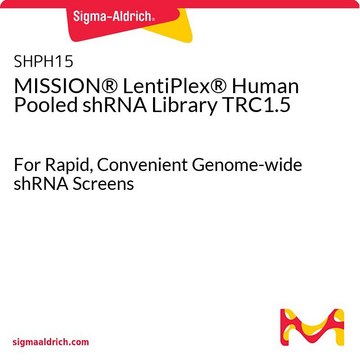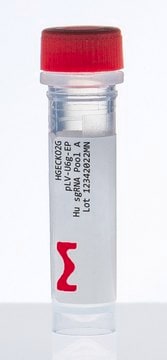SHPHLIBR
MISSION® LentiPlex® Complete Human Pooled shRNA Library
For Rapid, Convenient Genome-wide shRNA Screens
About This Item
Empfohlene Produkte
Qualitätsniveau
Produktlinie
MISSION®
Konzentration
≥5x108 VP/ml (via p24 assay)
Methode(n)
capture ELISA: 5 x 108 TU/mL using p24
Versandbedingung
dry ice
Lagertemp.
−70°C
Allgemeine Beschreibung
The MISSION LentiPlex Complete Human shRNA Pooled Library is a genome-wide lentiviral pool produced using a proprietary process. The library consists of over 125,000 shRNA constructs from the TRC collection targeting 20,000+ human genes. Each library is tested for shRNA representation before product release to ensure robust library coverage. The library is provided in ready-to-use lentiviral format at titers of at least 5 x 108 TU/ml via p24 assay and is pre-divided into sixteen subpools of approximately 6,000-8,000 shRNA constructs each. Amplification and sequencing primers are also provided for downstream target identification.
For more information including sample data and uses, please visit our LentiPlex Technical Detail Page.
Sonstige Hinweise
Amplification and sequencing primers are also provided for downstream hit identification.
Deconvolution of shRNA Pools
Sigma′s deconvolution service lets you easily identify the genes that impact your pooled shRNA screen.
- Next-generation sequencing of clonesgives a precise number of individual clone occurrence within a pooled shRNA sample
- Comprehensive, reproducible results from pooled shRNA screens
- Statistically robust and information-rich data
Contact your local Sigma sales representative for more information or submit an inquiry to MISSION RNAi
Rechtliche Hinweise
Ähnliches Produkt
Lagerklassenschlüssel
12 - Non Combustible Liquids
WGK
WGK 3
Flammpunkt (°F)
Not applicable
Flammpunkt (°C)
Not applicable
Analysenzertifikate (COA)
Suchen Sie nach Analysenzertifikate (COA), indem Sie die Lot-/Chargennummer des Produkts eingeben. Lot- und Chargennummern sind auf dem Produktetikett hinter den Wörtern ‘Lot’ oder ‘Batch’ (Lot oder Charge) zu finden.
Besitzen Sie dieses Produkt bereits?
In der Dokumentenbibliothek finden Sie die Dokumentation zu den Produkten, die Sie kürzlich erworben haben.
Kunden haben sich ebenfalls angesehen
Artikel
Our lentiviral vector systems are developed with enhanced safety features. Numerous precautions are in place in the design of our lentiviruses to prevent replication. Good handling practices are a must.
Successful targeting relies on optimizing key sensitive steps in the process, including lentiviral transduction. Below are some helpful handling and titration tips from our R&D lentiviral experts.
Protokolle
You are not alone designing successful CRISPR, RNAi, and ORF experiments. Sigma-Aldrich was the first company to commercially offer lentivirus versions of targeted genome modification technologies and has the expertise and commitment to support new generations of scientists.
FACS (Fluorescence-Activated Cell Sorting) provides a method for sorting a mixed population of cells into two or more groups, one cell at a time, based on the specific light scattering and fluorescence of each cell. This method provides fast, objective, and quantitative recording of fluorescent signals from individual cells.
Unser Team von Wissenschaftlern verfügt über Erfahrung in allen Forschungsbereichen einschließlich Life Science, Materialwissenschaften, chemischer Synthese, Chromatographie, Analytik und vielen mehr..
Setzen Sie sich mit dem technischen Dienst in Verbindung.













